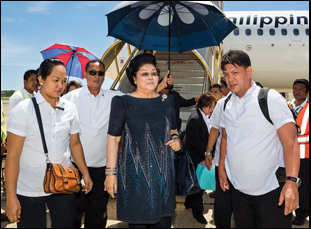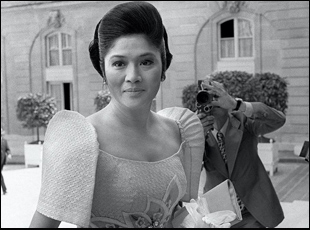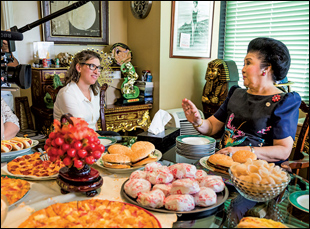When Lauren Greenfield would visit the house of Imelda Marcos, the former first lady of the Philippines who left the country in disgrace in 1986, only to return in 1991, she was well aware that many of the items that were around the house had been arranged for the benefit of her cameras, no doubt wanting to convey a narrative of opulence more impressive than any other than any other Greenfield had encountered before, even when past subjects such Jackie and David Siegel had set their sights on building the largest mansion in America modeled on the Palace of Versailles in “The Queen of Versailles” (before the financial meltdown of 2008 left it incomplete).
Although Marcos feigned mild concern that the house was going to be repossessed soon by the authorities, she wanted to let Greenfield see for herself that things hadn’t changed much despite her time in exile – the 1000-plus shoe closet that once was a symbol of the billions that Marcos and her husband Ferdinand had plundered from the country during his presidency appeared to have been completely restocked and walking past the area of the palatial estate that Marcos referred to as the gymnasium, the filmmaker was taken with another ornate display, even if it wasn’t necessarily meant for her eyes.
“That’s where all the court documents for U.S. versus Marcos were laid out as if it was a museum, and I don’t think that was for us because I went there multiple times and it was always like that, but I think that is part of her presenting her view,” says Greenfield. “Anybody else who saw those documents would think it was proof of her guilt. It’s like money laundering city [with] banks around the world, but for her, it’s proof of her innocence because she won the case.”
You can wonder throughout Greenfield’s latest film “The Kingmaker” how much Marcos actually believes in the story she tells of her charmed life, waxing on nostalgically about an era in the Philippines rife with embezzlement and violent reprisals on political enemies, but the reality is that no matter how much truth there is in it, the world has bent towards her way of looking at things, with no further evidence needed than the fact she’s giving an interview from the comfort of her home. In many ways, Marcos is the ultimate subject for the filmmaker who has long appreciated how wealth can warp one’s perspective, and it’s been one of Greenfield’s considerable gifts throughout her career to be able to give her subjects a chance to see themselves regally while allowing audiences into their rarefied air to comprehend the more obscene aspects of their fortune.
Yet the over-the-top excess that the still photographer and filmmaker has captured in both personal holdings and mythmaking usually hasn’t had the geopolitical ramifications that are in “The Kingmaker” where Greenfield’ initial conversations with Marcos give way to full on access to observe an unthinkable resurrection of her empire when her son Bongbong is encouraged to run for vice president concurrent with the rise of the strongman Rodrigo Duterte. (In the Philippines, they run separate campaigns.) While the former First Lady’s charisma alone could provide some cover for crimes of the past, her brazen reinterpretation of history and willingness to hand out pesos to sick kids and prospective voters to be seen as compassionate would have you forget what type of government the genial-appearing Bongbong would be ushering in, except for the fact that Greenfield spends her time away from the Marcoses visiting with political dissidents who were imprisoned or otherwise silenced during Ferdinand’s presidency and traveling to the island of Caluit for equally damning testimony from employees of the private zoo Imelda stocked with giraffes and zebras for her entertainment, only to leave them to languish once she lost interest.
But that’s about the only way boredom could be used in a sentence describing “The Kingmaker,” a film that is every bit as entertaining as it is revelatory, and in the midst of a whirlwind tour this fall after keeping the five-year project a secret with stops at Toronto, Telluride, Venice and this week, DOC NYC, Greenfield spoke about filming in the Philippines and documenting history in a way that can’t be denied.

Well, you can probably see the connection with “Generation Wealth.” Imelda Marcos has always been an iconic reference in my mind as I was looking at wealth because of her being famous for having 3000 pairs of shoes, but I really did not know much about her. I read this article by a journalist named William Mellor about [Calauit] the animal island and I thought that is the ultimate extravagance and shows the unintended consequences of wealth and power [since it] involved living things – animals – and also human rights with indigenous people being kicked off the island, all because she [creates] it on a whim. Four generations of inbreeding later, where they don’t have food or vets or the parents who brought them there, what ended up happening was all the animals were dead, and she hasn’t had any contact with the animal island, so I had to go there and discover there were as many animals there as when they first came over, and it was important for me to show how this was a place with life and indigenous people, but she was completely unaware of it.
So I thought it was a historical tale [at first], but as the Marcoses began to come back and have this really unexpected rise to power as Bongbong Marcos ran for the vice presidency, it really shifted the film into a contemporary narrative about wealth and power and their ability to rewrite history and come back through the money. Then when Duterte won [the presidency], it was the ultimate lesson about how when we don’t remember history, we’re condemned to repeat it.
This may be naive to ask, especially with someone as famous as Imelda Marcos, but how much do you generally want to know about your subjects before creating a portrait of them, whether it’s here or in photography? Because I could see the value in meeting them on their own terms as much as possible.
Well, I’m different from Imelda. Imelda says, “I didn’t want to read much about the leaders I was meeting,” when she talks about her friends Qaddafi and Saddam Hussein and Chairman Mao. [laughs] With someone like Imelda Marcos, you do have to do a lot of research, particularly as a foreigner doing this story. I worked really closely with a Filipino producer and a big Filipino film team. I also read extensively about her beforehand. After Bill Mellor article got me interested, I watched a really great portrait film by Ramona Diaz called “Imelda,” which in a way takes her up until the time [depicted in “The Kingmaker”] and was a biopic portrait, so I went in not wanting to do that, but really wanting to do something different with the island and with the political story.
The history is really important to her character and understanding the film, but I tried to bring in the history as you need to know it, and I worked with Per Kirkegaard, a Danish editor who brought in a lot of the archival, and I was really clear with him within the process that we’d really tried to use the archival very judiciously, not telling her whole history or the whole history of the Marcoses, but really using it as a way to understand her character and what the Philippines had been through and what was the significance of what was going on now, with an eye for truth-telling. I realized early on that Imelda Marcos was an unreliable narrator, so I knew that I needed a way to tell the audience what really happened and aligned with historical accounts and first-person testimonials.

That was a really important part of the process and yet, like the animal island, nobody really knew that much about it, so we were able to really be the first to go in deep on that. Because we shot over a hundred days over five years, there wasn’t really anybody else covering the political rise to power in the kind of depth we were doing, just because we happened to be there and we stuck with it, so by the time Duterte won, we were able to bring together, especially in the United States, a breaking news development In the connection between Duterte and the Marcoses and this return to the strongman and authoritarian regimes [with] the Marcoses getting back in power through him.
What was covering the campaign like?
It was really hard and very unexpected production-wise because it was many, many more days than we had planned for. We just ran for it. The exciting thing about Filipino politics and the challenge is it’s pretty chaotic, and there’s like a scrum around [the politicians] and you get right in there and you can get super close. It was at the very end of the edit that I found a photograph I had taken of Duterte where I’m just right in his face and he’s looking straight at me with red eyes and you couldn’t imagine being that close to a candidate. I covered the McCain campaign for the New York Times Magazine and John Kerry for Fortune and that respectful distance you don’t have in the Phillippines.
We were lucky that the Bonging Marcos campaign allowed us really great access, and it was interesting because it was so transparent – we really talk about the role of money in elections and how it can be used for influence, but we don’t actually see somebody handing out money to prospective voters, so This very intimate and very transparent access really gave us a window into so many things that are reflections of the United States’ situation and what’s going on in the rest of the world with the rise of nationalism.
By the end of the film, you realize that Bongbong and his sister Imee will both carry political clout for years to come. Were you actually covering both and Bongbong became more prominent?
Yeah, I was definitely covering Bongbong more prominently because he was the son – the prince – and he was the one who was going for the vice presidency. And Imee, at the time, was governor and she was in the north and didn’t have plans for national office, and I think it’s true that she really has the political skill of the family. Of course, she becomes Senator. But in my presentation reel for [potential distributors for the film], Bongbong wasn’t even in it because he so lacked the charisma of his mother in the beginning that I didn’t think he was a compelling character. He became compelling when it was clear he was a kind of pawn to his mother’s plan.

She must’ve set that up for us, but also there are a lot of things in her world that are part of her rewriting history the way she wants it and this is so interesting because it’s really the opposite [from what you think]. We got there and I think she art directs what she wants my cameras to see, so [there’s that scene] when she moved the gold sheep so that we’re seeing it towards camera. But what was amazing about the sequestered home is that even though she says “we don’t know how long we can stay here so we’re not fixing it up,“ [the family] actually just uses it like it’s theirs, so they have tons of stuff there. The shoe closet that’s in the movie was from that house and the shoes are not dusty – they look like they’re in use. So as Mrs. Marcos would say, “The government tries to put it up for sale, but nobody’s going to buy it because nobody wants to take it away from the Marcoses.
Having kept this project a secret for the past few years, what’s it been like to have it out in the world?
It’s really exciting. We did not talk about the project for a long time and I’m really glad it’s coming out now when it’s such a reflection of what’s going on for us too in the United States and in Europe with the rise of nationalism and also in the Philippines where it’s such a dire situation. The trailer has gone viral there. Senator Lima, who’s been in jail for two years for trumped up drug charges by Duterte, posted the trailer, so we’re hopeful that it’ll make a difference in the Philippines and if not, at least be a cautionary tale for us.
“The Kingmaker” opens on November 8th in Los Angeles at the Laemmle Royal and New York at the Quad Cinema. It will also screen at DOC NYC at the Cinepolis Chelsea on November 6th at 8:45 pm and November 7th at 3:30 pm and AFI Fest in Los Angeles on November 17th at 8:45 pm at the TCL Chinese.




